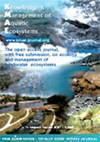Additional molecular data on the protected springsnail species Bythinella viridis (Poiret, 1801) (Gastropoda: Bythinellidae) suggest synonymy of related taxa
IF 1.7
3区 环境科学与生态学
Q3 FISHERIES
引用次数: 1
Abstract
The taxonomic status of the springsnails B. viridis, B. carinulata and B. lancelevei remains unclear despite the molecular evidence data provided by Benke et al. (2009). Based on extensive sampling and the analysis of COI, 16S, 28S and ITS genes, we investigate analyze the genetic variability of Bythinella populations sampled within the area of occurrence of the three nominal taxa. Topotypic populations of B. lancelevei and B. viridis cannot could not be distinguished. Some of the populations included in the putative area of distribution range of B. carinulata form distinct supported clades, but these distinct clades are not monophyletic and the overall genetic divergence is less than the 3% barcoding gap for species of the genus the barcoding gap of c.a. 3% for Bythinella species. Therefore, we propose to synonymize these three nominal species under the name B. viridis (Poiret, 1801). Our results have important conservation implications, as they significantly expand the range of the protected species B. viridis. This species should be considered in impact studies in a large northeastern quarter of France.对受保护的春螺种Bythinella viridis (Poiret, 1801)(腹足目:Bythinellidae)的分子资料分析表明其与相关分类群同义
尽管Benke et al.(2009)提供了分子证据数据,但弹簧蜗牛B. viridis、B. carinulata和B. lancelevei的分类地位仍不清楚。在广泛取样和COI、16S、28S和ITS基因分析的基础上,对3个名义分类群发生区域内的飞虫属群体进行了遗传变异分析。蓝杉白僵菌和绿僵菌的形态种群无法区分。在推测分布范围内的部分居群形成了不同的支系,但这些支系不是单系的,总体遗传差异小于该属种的3%的条形码差距,而Bythinella种的3%的条形码差距。因此,我们建议将这三个名义物种同义命名为B. viridis (Poiret, 1801)。我们的研究结果具有重要的保护意义,因为它们显著地扩大了保护物种绿芽孢杆菌的范围。在对法国东北部大片地区进行影响研究时应考虑到这一物种。
本文章由计算机程序翻译,如有差异,请以英文原文为准。
求助全文
约1分钟内获得全文
求助全文
来源期刊

Knowledge and Management of Aquatic Ecosystems
环境科学-海洋与淡水生物学
CiteScore
3.70
自引率
5.60%
发文量
22
审稿时长
>12 weeks
期刊介绍:
Knowledge and Management of Aquatic Ecosystems (KMAE-Bulletin Français de la Pêche et de la Pisciculture since 1928) serves as a foundation for scientific advice across the broad spectrum of management and conservation issues related to freshwater ecosystems.
The journal publishes articles, short communications, reviews, comments and replies that contribute to a scientific understanding of freshwater ecosystems and the impact of human activities upon these systems. Its scope includes economic, social, and public administration studies, in so far as they are directly concerned with the management of freshwater ecosystems (e.g. European Water Framework Directive, USA Clean Water Act, Canadian Water Quality Guidelines, …) and prove of general interest to freshwater specialists. Papers on insular freshwater ecosystems and on transitional waters are welcome. KMAE is not a preferred journal for taxonomical, physiological, biological, toxicological studies, unless a clear link to ecological aspects can be established. Articles with a very descriptive content can be accepted if they are part of a broader ecological context.
 求助内容:
求助内容: 应助结果提醒方式:
应助结果提醒方式:


